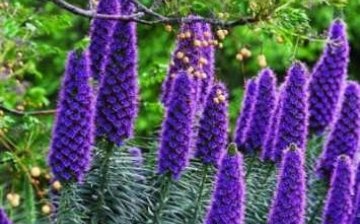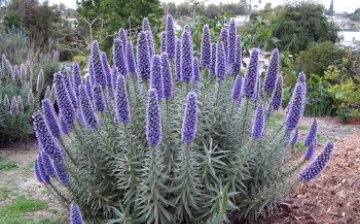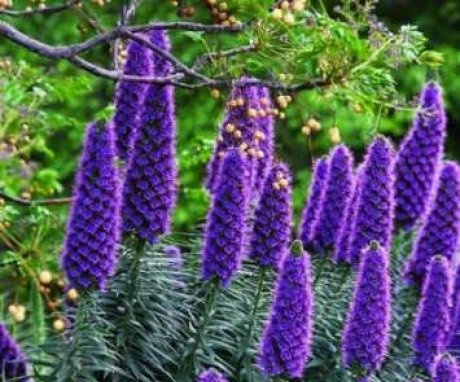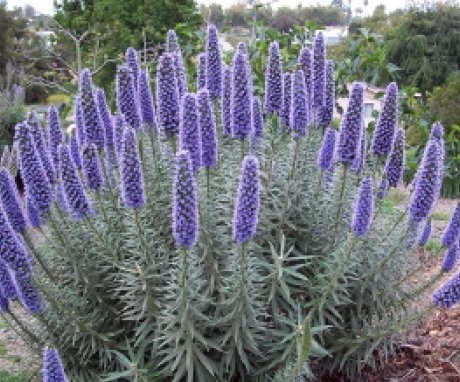Echium: types, care and reproduction of the plant
Echium, or as it is popularly called, bruise or early blue, is a herbaceous plant that belongs to the borage family. Its homeland is the Mediterranean, Africa, where perennial species are found. In cold regions, only annuals grow, since the plant does not tolerate frost and cold well. Echium in height can reach 120 cm, it has a straight stem with stiff hairs. In the wild, it is found in the fields, along the roadsides. In the decorative world, several beautiful species have been bred for flower beds, gardens and parks.
Content:
Types of echium
Echium Wildpreta:
- The homeland of this type of echium is Southern Europe. You can meet him all over the world, because thanks to his decorative qualities often used in landscaping and simply decorates private and public gardens and parks.
- The stem can reach a height of up to 2.5 meters.
- Echium Wildpreta is a biennial plant. In the first year, only a deciduous rosette grows, in the 2nd year a pyramidal ear appears, and small reddish flowers are located on it, similar in appearance to bells, which are collected in panicles.
- The leaves of this plant are lanceolate, pubescent, gray-green in color, can reach 20 cm in length.
- For planting, a place with well-drained rocky soil is selected.
- The flowering period is from late spring to mid-summer.
Echium ordinary:
- This type of echium is not decorative, it can be easily found in the fields, along the roads.
- The stem grows to a height of 30-100 cm. Light green, thick and fleshy stem is covered with hard hairs.
- Leaves are green, whole, lanceolate.
- The buds of this type of echium are pink in color, and the open flower is painted in a blue tone.
- Flower shape - deep calyx with five petals. The period of opening the buds is almost all summer.
- The plant itself is poisonous, but it is often used for medicinal purposes.
Also, Echium ordinary is a honey plant.
Echium blush red:
- It grows mainly in mountainous and foothill areas, without forming dense thickets. Refers to biennial plants.
- The stem can be up to 1 meter in height.
- Leaves are elongated, sharp, oblong, strongly pubescent.
- The flowers are oblong, collected in inflorescences, have a purple color.
- The fruits of this plant resemble egg-shaped nuts.
Care and reproduction
Echium plant is unpretentious and does not require special care. However, it is worth keeping an eye on soil moisture.
With excessive moisture and stagnant water, the plant may die. Therefore, watering is carried out as the soil under the plant dries out. Echium also gets along well with any types of ornamental plants.
Plant propagation occurs with the help of seeds:
- To obtain seedlings, they are sown in wide pots or boxes.
- For this, early spring is suitable, for example, April.
- When the seedlings grow up a little, they are dived and planted in separate pots.
- Landing in the ground should be done during a warm period, for example, in mid-May.
- Sprouts are planted in soil with good drainage. There should be 30 to 45 cm between the plants.
- If planted densely, development and growth will not be fast enough and flowering may begin later than normal.
You can also sow seeds in the ground, without first forcing seedlings at home.To do this, you must wait until the end of the frost. With this sowing, an adult plant blooms much later than the one that was planted from seedlings. Seedlings appear 2-3 weeks after sowing. During this period, they must be thinned out.
In the future, timely watering and loosening of the soil will give the plant everything it needs for good growth and flowering.
By winter, after flowering, the plant is thrown away, and the next year new seeds are prepared. But there are several decorative species that can be transplanted into a pot for the winter, and planted again in open ground in the spring.
Plant application
Decorative types and varieties are used in landscape design. Echium looks very beautiful and impressive in flower beds and gardens.
Echium is also a good honey plant and is specially sown in the fields. The honey collected from the flowers of this plant has a pleasant smell and taste. This honey belongs to the first grade.
Echium's medicinal properties:
- Some types of echium are medicinal... For such purposes, the plant is harvested during the flowering period for subsequent drying. An infusion of this herb is good for coughing, as an expectorant and sedative.
- An infusion of this herb is often used in folk medicine. Echium lotions help with rheumatism or tendon sprains.
- The roots of echium are also used in folk medicine. The decoction of the roots is used as a blood purifier.
Echium oil is used in cosmetology. It tones, prevents moisture loss and is a good antiseptic. Used in creams and masks. Well nourishes the skin and regenerates cells. It neutralizes free radicals well.
More information can be found in the video.














I remember that at first I was surprised that BLUE can also be red. In general, a very beautiful plant for the garden and easy to grow.